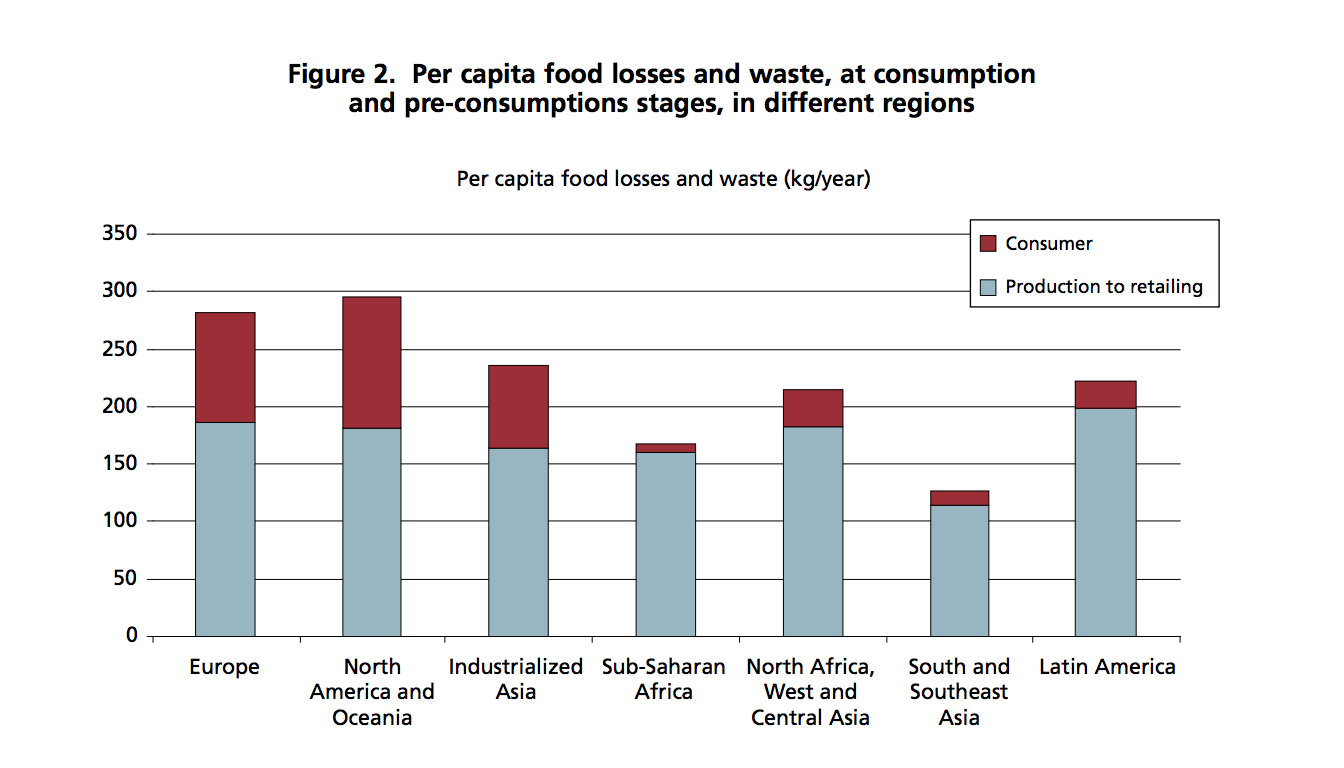How Food Waste Differs in Low and High Income Countries
10/9/2020
It is estimated that about one third of all the world’s food is never consumed. This means that all the resources, greenhouse gases, and land utilized to grow this produce were unnecessary in their contribution to climate change. Food waste alone is responsible for 8% of our global emissions. When food waste and organic matter is placed within landfills it releases methane gas, a greenhouse gas which is 84 times more potent than carbon dioxide with regard to the warming of our planet.
 Source: Food and Agriculture Organization of the United Nations
Source: Food and Agriculture Organization of the United NationsAs shown by this figure, per capita food waste within Europe and North America is roughly 300 kg/yr, whereas it is only about 150 kg/yr in Sub-Saharan Africa and South/Southeast Asia. In addition, per capita consumer food waste within Europe and North America is about 100 kg/yr as compared to the 6-11 kg/yr produced by Sub-Saharan Africa and South/Southeast Asia. It is crucial to understand the distinction between food waste within high-and low-income countries. Although it is an issue prevalent in both countries, one stems from systemic change whereas another is the product of unrecognized privilege.
How Food Becomes Waste in Low Income Countries
Within developing countries over 40% of food loss occurs after harvest and during processing. Although waste is largely unintentional within low income countries, it is interesting to note that it typically occurs earlier within the food system rather than at the consumer level. Examples of this include food rotting on farms or spoiling in the processing and distribution stages of preparation. For this to be resolved it is crucial for these countries to have the means to improve infrastructure for storage, processing, and the transportation of food. These will also be crucial systems to invest in to meet the ever increasing global demand for food.Food Waste in High Income Countries
For industrialized countries, over 40% of food waste happens at the consumer and retail level. Food wasted within high income countries is almost equivalent to all food produced in sub-Saharan Africa, 222 million tons lost as compared to 230 million tons produced. Consumers reject food for a plethora of reasons including discoloration, bruises, or simply buying too much that it rots before ever consumed. This food loss comes from a place of ignorance as many citizens and retailers do not understand the harm of their food waste. Rather than having to invest in improved infrastructure we must redirect our resources to educating the public on more responsible consumer habits and the impact the absurd amount of edible food wasted has upon climate change. These changes can be as simple as the average person planning out their groceries ahead of time so they do not purchase unnecessary items that will eventually be thrown away, or as complex as diverting funds to educating and implementing a composting program across America.In fact, it was this exact contrast in how countries contribute to food waste that inspired the founders of DeWaste. Paran Sonthalia, CEO of DeWaste, reflected upon this variation in food waste when founding this company,
“With my parents being immigrants from India, I was always told to never leave food on my plate because there are so many people who cannot manage even 2 meals a day. Seeing the issue of food waste first hand in India is disheartening and seeing people waste plates full of food in the US is even worse. We knew we had to do something about it because food is a privilege that not everyone has.”
Pranshu Bansal, COO, had a similar sentiment regarding the difference in how industrialized and developing countries value food,“40% of prepared food goes to waste in developed countries vs 10% in developing countries. This metric tells me how people in developed countries look at food on their plates with a certain amount of privilege that poor countries cannot afford to have.”
It is personal connections, such as Paran and Pranshu’s, that inspire innovation to solve crises our world is facing. DeWaste strives to work to diminish the gap between retail food waste that is produced in countries such as America as compared to other countries including India. Our company draws from individual experiences to create our latest products and make meaningful change in an issue we are so passionate about.Be the first to learn about the latest DeWaste news.
